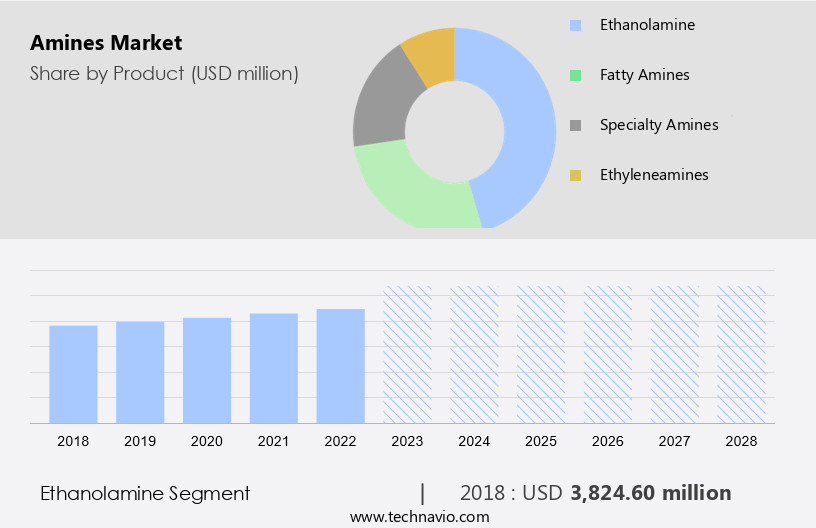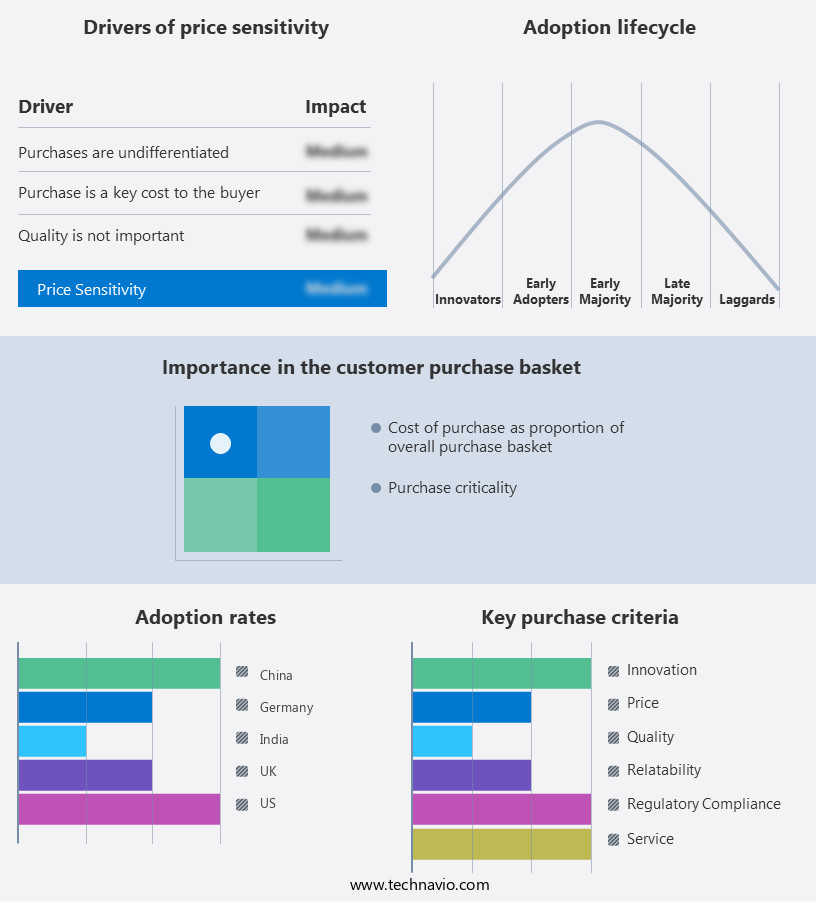Amines Market Size 2024-2028
The amines market size is forecast to increase by USD 2.45 billion at a CAGR of 4.36% between 2023 and 2028.
The market is experiencing significant growth due to the burgeoning demand for these compounds in various industries, particularly in agrochemicals and pharmaceuticals. The increasing usage of amines as intermediates In the production of agrochemicals, such as pesticides and herbicides, is driving market growth. Moreover, the pharmaceutical industry's reliance on amines as building blocks for producing drugs is another major growth factor. However, the hazardous nature of amines poses a significant challenge to market growth. Strict regulations regarding their production, handling, and disposal are necessary to mitigate risks associated with their use. Proper safety measures and adherence to regulatory guidelines are essential to ensure the safe and sustainable production and consumption of amines.In summary, the market is witnessing robust growth due to its extensive applications in agrochemicals and pharmaceuticals, but the market's expansion is constrained by the hazardous nature of these compounds and the stringent regulations governing their production and use.
What will be the Size of the Amines Market During the Forecast Period?

Request Free Sample
The market encompasses a diverse range of organic compounds that contain a nitrogen atom bonded to one or more alkyl or aryl groups. These versatile chemicals play essential roles in various industries, including surfactants for enhancing product performance and stability, crop protection chemicals as active ingredients, and intermediates In the production of plastics, insulation materials, and polyurethanes. The global population's increasing demand for food, water treatment, and personal care products drives the market's growth. Amines find applications in numerous sectors, such as agriculture, where they serve as essential components of fertilizers and pesticides. In the industrial sector, they are used as intermediates In the production of dyes, pharmaceuticals, and solvents.Their unique properties, like uptake and absorption capabilities, make them indispensable in hard water treatment and water treatment applications. Despite their widespread use, environmental concerns and regulations, particularly regarding their production and disposal, pose challenges to the market. Primary and secondary amines, like methylene diphenyl isocyanate, monoethanolamine, and triethanolamine, are subject to stringent regulations due to their potential health and environmental hazards. The agricultural sector's reliance on amines for fertilizers and pesticides also raises food safety concerns, further emphasizing the need for sustainable production methods and rigorous regulations.
How is this Amines Industry segmented and which is the largest segment?
The amines industry research report provides comprehensive data (region-wise segment analysis), with forecasts and estimates in "USD million" for the period 2024-2028, as well as historical data from 2018-2022 for the following segments.
- Product
- Ethanolamine
- Fatty amines
- Specialty amines
- Ethyleneamines
- Application
- Pesticides
- Surfactants
- Personal care
- Lubricants
- Others
- Geography
- APAC
- North America
- Europe
- Middle East and Africa
- South America
By Product Insights
- The ethanolamine segment is estimated to witness significant growth during the forecast period.
Ethanolamine, chemically known as 2-aminoethanol, is a viscous, alkaline liquid with an unpleasant ammonia-like odor. It is miscible with water and several oxygenated organic solvents, such as methanol, acetone, and glycerol. Ethanolamine plays a significant role in various industries. In the chemical sector, it functions as a gas scrubber, removing carbon dioxide, hydrogen sulfide, and other acidic pollutants from waste gas streams. It is also used as a starting material for manufacturing surfactants, chelating agents, and pharmaceuticals. In the personal care industry, ethanolamines act as cleansing agents, removing dirt and oil from the skin by dissolving grease and blending other essential ingredients.
Ethanolamines find extensive applications in end-use industries, including crop protection, paints and coatings, cosmetics, industrial cleaners, asphalt additives, and insulation materials. They are integral to the production of Methylene diphenyl isocyanate (MDI), a crucial component In the manufacture of polyurethane, plastic, polymer, rubber, and agrochemicals. Ethanolamine's versatility extends to various applications, including water treatment, gas treatments, and the production of epoxy coatings, industrial maintenance, and civil engineering. Ethanolamine's derivatives, such as monoethanolamine and triethanolamine, serve as corrosion inhibitors, lubricants, and coolants in various industries. The demand for ethanolamine is driven by its extensive applications in surfactant production and the growing demand for personal care and crop protection products.

Get a glance at the Amines Industry report of share of various segments Request Free Sample
The Ethanolamine segment was valued at USD 3.82 billion in 2018 and showed a gradual increase during the forecast period.
Regional Analysis
- North America is estimated to contribute 34% to the growth of the global market during the forecast period.
Technavio’s analysts have elaborately explained the regional trends and drivers that shape the market during the forecast period.

For more insights on the market share of various regions, Request Free Sample
The Asia Pacific (APAC) region holds substantial growth opportunities for The market, given their extensive applications. Globally, APAC leads the market in terms of demand and innovation. Key drivers for the APAC the market include advancements in end-use industries, such as water treatment, agrochemicals, oilfield chemicals, and asphalt additives. Major manufacturers have established their presence in APAC due to factors like relaxed regulations, a large customer base, and low labor costs. The APAC the market is projected to exhibit a higher Compound Annual Growth Rate (CAGR) compared to other regions, primarily due to the increasing utilization of amines In the production of cleaning agents, pesticides, and personal care products.
Market Dynamics
Our researchers analyzed the data with 2023 as the base year, along with the key drivers, trends, and challenges. A holistic analysis of drivers will help companies refine their marketing strategies to gain a competitive advantage.
What are the key market drivers leading to the rise In the adoption of Amines Industry?
Burgeoning demand for amines in agrochemicals is the key driver of the market.
Amines are organic compounds that contain a nitrogen atom bonded to one or more alkyl or aryl groups. They are widely used in various industries due to their unique properties and versatile applications. In the surfactant market, amines, particularly fatty amines and ethanolamines, serve as essential ingredients. These non-ionic surfactants are utilized as wetting and dispersing agents, sanitizers, stabilizers, and defoamers in industries such as textile, paper, chemical, paint, drilling, metal, and others. In the agrochemical sector, amines are used for the production of pesticides, dyes, and as intermediates In the synthesis of various agrochemicals. The demand for amines in this sector has risen due to the increase In the cultivation of genetically modified crops, which require specific herbicides and pesticides.Additionally, amines are used In the production of crop protection chemicals, including herbicides, fungicides, and insecticides. Furthermore, amines are used In the personal care industry for the production of cosmetics, personal hygiene products, and self-care items. Ethanolamines, alkylamines, and fatty amines are commonly used as emulsifiers, solvents, and intermediates In the production of various personal care products, such as foaming agents, eyeliners, foundations, mascara, shaving products, and hair-care products. The market is driven by the increasing demand for surfactants, crop protection chemicals, and personal care products. The rising population and the need for industrial development have led to an increase In the demand for these products.However, the market is faced with several restraining factors, including regulatory environment and raw material availability. Despite these challenges, leading manufacturers continue to innovate and provide solutions for various applications, including water treatment, gas treatment, and industrial cleaners. In the industrial sector, amines are used in various applications, including asphalt additives, insulation materials, corrosion inhibitors, lubricants, machining fluids, cooling systems, and oleo chemical production. They are also used In the oil field, refinery applications, and epoxy hardeners. The demand for amines In these applications is expected to grow due to the increasing industrialization and the need for chemically resistant systems in various industries.In conclusion, the market is a significant and diverse market, with applications ranging from agriculture to personal care and industrial sectors. The demand for amines is driven by the increasing population, industrialization, and the need for various products and solutions. Despite the challenges, leading manufacturers continue to innovate and provide solutions for various applications, ensuring the continued growth of the market.
What are the market trends shaping the Amines Industry?
Increasing demand from pharmaceutical industry is the upcoming market trend.
Amines are essential organic compounds derived from ammonia (NH3) by replacing one or more hydrogen molecules with alkyl or aryl groups. These nitrogen-containing organic compounds exhibit diverse structures, including primary, secondary, and tertiary amines, as well as aliphatic and aromatic amines. The market encompasses a wide range of applications, including surfactants, crop protection chemicals, end-use industries, and various chemical processes. In the realm of surfactants, amines serve as crucial ingredients in various industries, such as personal care, agriculture, and industrial applications. For instance, they function as foaming agents in personal care products like shaving creams, foaming hand washes, and bath foams.In the agricultural sector, amines contribute to the production of pesticides and herbicides, enhancing crop yields and protecting arable land from pests and diseases. Moreover, amines play a significant role In the manufacturing of polymers, such as polyurethane, plastic, rubber, and insulation materials. These polymers find extensive applications in various industries, including construction, transportation, and electronics. Amines are also used as intermediates and additives In the production of solvents, catalysts, emulsifiers, stabilizers, scrubbing agents, and corrosion inhibitors. In the pharmaceutical industry, amines are indispensable as intermediates and solvents In the synthesis of various drugs. For example, they are used In the production of antipsychotics, cholesterol-lowering drugs, local anesthetics, and anticancer agents.Additionally, amines are employed as catalysts and solvents In the production of pseudoephedrine, benzonatate, and cysteamine. The market is driven by the increasing demand for surfactants, particularly In the personal care and agricultural sectors. The rising demand for crop protection chemicals, personal care products, and industrial cleaners also contributes to market growth. Furthermore, the expansion of the pharmaceutical industry and the increasing focus on innovation and solutions for chemical processes further bolster market growth. However, the market faces certain restraining factors, including regulatory challenges and the environmental impact of amine production. The regulatory environment is becoming increasingly stringent, with various agencies imposing strict regulations on the production and use of amines due to their potential health and environmental hazards.Additionally, the high energy consumption and greenhouse gas emissions associated with amine production pose environmental concerns. Despite these challenges, the market continues to grow, driven by the increasing demand for bio-based products and the ongoing research and development efforts to improve the production processes and reduce their environmental impact. For instance, the demand for surfactants in water treatment and gas treatments is on the rise, as they play a crucial role in ensuring water and air quality. Similarly, the increasing use of amines In the production of epoxy coatings, industrial maintenance, civil engineering, and animal feed is expected to drive market growth.In conclusion, the market is a dynamic and evolving industry, driven by the increasing demand for surfactants, crop protection chemicals, and pharmaceutical intermediates. Despite the regulatory challenges and environmental concerns, the market continues to grow, fueled by innovation and the ongoing efforts to improve production processes and reduce their environmental impact. The future of the market looks promising, with a focus on sustainable production methods and the development of new applications in various industries.
What challenges does the Amines Industry face during its growth?
Hazardous nature of amines is a key challenge affecting the industry growth.
Amines, a class of organic compounds containing a nitrogen atom bonded to one or more alkyl or aryl groups, play a significant role in various industries, including surfactants, crop protection chemicals, end-use industries, and petrochemicals. The market is driven by the rising demand for surfactants, particularly In the personal care and agricultural sectors. In the personal care industry, amines are used as emulsifiers, stabilizers, scrubbing agents, and solvents In the production of cosmetics, shaving products, and hair-care products. In the agricultural sector, amines are used as intermediates and catalysts In the production of pesticides and fertilizers. The MDI segment of the market is a major contributor to the insulation materials industry, where it is used to produce polyurethane, a versatile polymer used In the production of plastic, rubber, and polymer products.Additionally, amines are used In the production of asphalt additives, epoxy hardeners, and corrosion inhibitors. However, the market growth is restrained by regulatory factors and the environmental impact of some amines. For instance, some aromatic amines and azo dyes used In the production of textiles and plastics can release carcinogenic and genotoxic substances into the environment. As a result, various regulatory bodies, such as the EU and the US, have imposed restrictions on the use of these substances. Moreover, the increasing demand for bio-based products and sustainable solutions in various industries is driving innovation In the production of specialty amines derived from natural sources, such as fats and oils.This trend is expected to continue as the world population grows and industrial development continues to expand, leading to increased demand for chemicals and additives in various end-use industries. In conclusion, the market is driven by the rising demand for surfactants, particularly In the personal care and agricultural sectors, and the versatility of amines in various industries. However, regulatory factors and environmental concerns are restraining factors that need to be addressed to ensure the sustainable production and use of amines. The market is also witnessing innovation In the production of specialty amines derived from natural sources, which is expected to drive growth In the future.
Exclusive Customer Landscape
The amines market forecasting report includes the adoption lifecycle of the market, covering from the innovator’s stage to the laggard’s stage. It focuses on adoption rates in different regions based on penetration. Furthermore, the amines market report also includes key purchase criteria and drivers of price sensitivity to help companies evaluate and develop their market growth analysis strategies.

Customer Landscape
Key Companies & Market Insights
Companies are implementing various strategies, such as strategic alliances, amines market forecast, partnerships, mergers and acquisitions, geographical expansion, and product/service launches, to enhance their presence In the industry.
Akzo Nobel NV - Amines, including ethylene amines and their derivatives, are among the offerings from the company. These organic compounds are widely used in various industries, such as pharmaceuticals, agrochemicals, and polymers, due to their versatile chemical properties. Ethylene amines, specifically, are primary raw materials for producing polyamides, elastomers, and solvents. The market for amines is expected to grow significantly due to increasing demand from end-use industries and ongoing research and development activities.
The industry research and growth report includes detailed analyses of the competitive landscape of the market and information about key companies, including:
- Akzo Nobel NV
- Arkema Group.
- Ascensus Specialties LLC
- BASF SE
- Biosynth Ltd.
- Celanese Corp.
- ChemImpex International Inc.
- Dow Chemical Co.
- Eastman Chemical Co.
- Enamine Ltd
- Huntsman International LLC
- INEOS AG
- LGC Science Group Holdings Ltd.
- Merck KGaA
- Otsuka Holdings Co. Ltd.
- Solvay SA
- SynQuest Laboratories Inc
- Thermo Fisher Scientific Inc.
- Tokyo Chemical Industry Co. Ltd.
- Toronto Research Chemicals Inc.
Qualitative and quantitative analysis of companies has been conducted to help clients understand the wider business environment as well as the strengths and weaknesses of key industry players. Data is qualitatively analyzed to categorize companies as pure play, category-focused, industry-focused, and diversified; it is quantitatively analyzed to categorize companies as dominant, leading, strong, tentative, and weak.
Research Analyst Overview
The market encompasses a broad range of organic compounds that contain a nitrogen atom bonded to one or more carbon atoms, forming alkyl and aryl groups. These versatile chemicals play a crucial role in various industries, including surfactants, crop protection, and end-use sectors such as plastics, polymers, rubber, and adhesives. Amines are integral to the production of surfactants, which are essential in various applications, including industrial and personal care. In the industrial sector, they serve as critical components in water and gas treatment processes, enhancing their effectiveness and efficiency. In the personal care industry, they are used In the manufacture of various products, including foaming agents, cosmetics, and personal hygiene items.
The crop protection segment is another significant market for amines, where they serve as intermediates and additives In the production of pesticides and herbicides. In the agricultural sector, amines are used as fertilizers and nutrient sources, contributing to increased crop yields and productivity. The demand for amines is driven by various factors, including the rising demand for surfactants in water and gas treatment applications, the growing need for crop protection, and the expanding personal care sector. Innovation and the development of new solutions continue to fuel growth In the market, with applications in industries such as pharmaceuticals, construction, and refining.
Despite the numerous benefits of amines, there are also challenges that hinder their widespread adoption. Regulatory environments and environmental concerns, including the potential impact on water resources and arable land, are among the key restraining factors. The market is diverse and dynamic, with various types of amines, including ethanolamines, alkylamines, fatty amines, and specialty amines, each with unique properties and applications. Ethanolamines, for instance, are used as corrosion inhibitors, lubricants, and solvents, while alkylamines are used as emulsifiers, stabilizers, and scrubbing agents. In the industrial sector, amines are used in various applications, including as corrosion inhibitors in cooling systems, as lubricants in machining fluids, and as epoxy hardeners in coatings.
They are also used In the production of oleo chemical products and as additives In the oil field. The market for amines is expected to continue growing, driven by the increasing demand for surfactants, the expanding personal care sector, and the growing need for crop protection. The development of bio-based products and the adoption of chemically resistant systems in various industries are also expected to fuel growth In the market. In conclusion, the market is a dynamic and diverse industry that plays a crucial role in various sectors, including surfactants, crop protection, and end-use industries. The market is driven by various factors, including the rising demand for surfactants, the expanding personal care sector, and the growing need for crop protection.
Despite the challenges, the market is expected to continue growing, driven by innovation and the development of new solutions.
|
Market Scope
|
|
Report Coverage
|
Details
|
|
Page number
|
178
|
|
Base year
|
2023
|
|
Historic period
|
2018-2022 |
|
Forecast period
|
2024-2028
|
|
Growth momentum & CAGR
|
Accelerate at a CAGR of 4.36%
|
|
Market growth 2024-2028
|
USD 2449.2 million
|
|
Market structure
|
Fragmented
|
|
YoY growth 2023-2024(%)
|
4.11
|
|
Key countries
|
China, US, UK, Germany, and India
|
|
Competitive landscape
|
Leading Companies, Market Positioning of Companies, Competitive Strategies, and Industry Risks
|
Request Free Sample
What are the Key Data Covered in this Amines Market Research and Growth Report?
- CAGR of the Amines industry during the forecast period
- Detailed information on factors that will drive the growth and forecasting between 2024 and 2028
- Precise estimation of the size of the market and its contribution of the industry in focus to the parent market
- Accurate predictions about upcoming growth and trends and changes in consumer behaviour
- Growth of the market across APAC, North America, Europe, Middle East and Africa, and South America
- Thorough analysis of the market’s competitive landscape and detailed information about companies
- Comprehensive analysis of factors that will challenge the amines market growth of industry companies
We can help! Our analysts can customize this amines market research report to meet your requirements.
Get in touch







![]() Get the report (PDF) sent to your email within minutes.
Get the report (PDF) sent to your email within minutes.
Complimentary full Excel data with your report purchase.